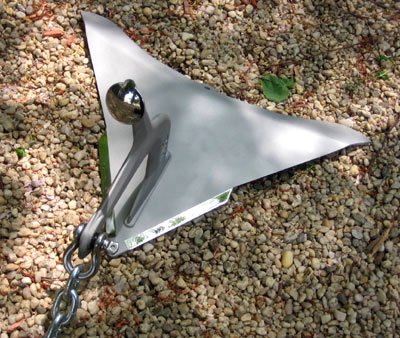This discussion is interesting. I definitely think that the different ideas presented here could be more regional and/or area specific, as least as to the conditions experienced and what works well for those conditions.
Here in the area of the coast of BC. Canada, we cannot see our anchor on the bottom without putting on a wet or dry suit and using SCBA gear to check it out. I have never seen anyone do that. Plus, as Murray has stated, sometimes anchoring on the mid coast is in depths of 100 feet. We have been anchoring regularly for over 16 years and over 1000 nights, so I have some experience (not new

). Here we get regular tidal changes of up to 24 feet in the more northern areas (my average would be 12+ feet). Therefore, in some areas, you may anchor in a reversing tidal stream, but we try to avoid the worst of it. We rarely anchor in anything but a very "wind protected" cove or bay so fetch would be small with only very small waves developing. Most often we anchor in sticky mud, sand, some weeds, or the odd time a rocky bottom. Only once have we dragged anchor. That occurred with a Rocna anchor that was lightly power set in a rocky bottom. It set well and easily in a narrow area where tidal stream would be felt more than other areas. We sat through 3 tide reversals with no problem, but on the 4th we dragged anchor (at 3AM of course). Wind was calm at the time. The normal location I would choose to anchor in this area was full, and places were limited. This was the first and only time I anchored where there was a poor bottom and I would have been located in the area of higher tidal flow. I don't blame my equipment or my technique for this happening. I blame my decisionmaking and perhaps was a bit overconfident

(lesson learned). However, I don't see how in this instance or for that matter in most others, how the "no power set" approach would have (or could have) given a different result.
To me, especially since I cannot see my anchor, I want to know it is set and it will hold
now. By "power setting" with a decent scope and using bearings to ensure we are not moving (dragging), gives us good comfort that we will be fine for the duration. As far as resetting (there are no guarantees); by using a good anchor with good scope, mostly all chain, and being at least a bit choosy as to location, I think that if it power set easily, it should reset itself as well.
I don't see how not power setting at first will have any bearing on the ability for the anchor to reset? Scope, anchor and rode type, and bottom material all will have an impact on resetting. I know of several people who have dragged anchor after being in the same location for a few days, so not power setting but figuring that just careful observation for a few hours is somehow more reliable than a power set is puzzling to me. On a few very rare occasions, we have not been able to obtain a set within a few feet of where we have dropped the anchor. I was happy to find that out right away, rather than after sitting in mild conditions for hours and then finding out, possibly "the hard way".
I am not be any means arguing that if good scope is laid out that a slight wind or current will not set an anchor. Obviously this does work. Personally, I just want to know I set, and know it right away. (Positive feedback)
Another point. In many areas around here (Gulf Islands, Desolation Sound), the anchorages can be very crowded in the summer with many boats using what I consider to be "short scope" (2-3 to 1). The odds of a successful reset go down when using such a short scope. Personally, I don't anchor with less than 4-1 (deeper water) and usually use 5-6 to 1 or more (when swing is not an issue or conditions warrant).
Anyway, there are many ways to "skin a cat" as the saying goes, and if it works for you and gives you confidence, that is what really counts.


